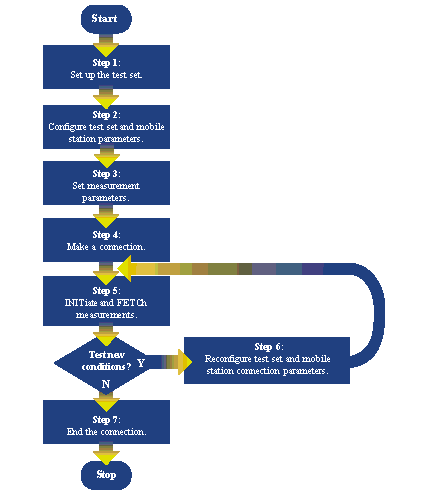Introduction
The Getting Started Guide is organized around the basic set of tasks a control program normally performs when testing a mobile station in a manufacturing environment.
- Step 1: Set up the Test Set
- Step 2: Configure Test Set and Mobile Station Parameters
- Step 3: Set Measurement Parameters
- Step 4: Make a connection
- Step 5: INITiate and FETCh Measurements
- Step 6: Reconfigure Test Set and Mobile Station Connection Parameters
- Step 7: End the Connection
Click on any step in the flowchart below to learn more about how to program the Keysight Technologies 8960 to perform these tasks.
Programming Flowchart

You can also use the navigation buttons on each page to move between steps, return to the flowchart, find more detailed information about each step, or to go the comprehensive example programs.

Conventions used in this Getting Started Guide
Throughout this Getting Started Guide the term "test set" refers to an Keysight Technologies 8960 Series 10 wireless communications test set with the E1966A 1xEV-DO Terminal Test Application installed.
The variable
Test_set
used in the steps of the Getting Started Guide refers to the test set's GPIB address.
About the Programming Examples Presented in this Guide
Programming Language:
Programming examples presented in this guide are written in the HTBasic for Windows. The use of HTBasic is not an endorsement of the HTBasic product.
Line Numbers
All of the programming examples in the guide with line numbers are sections from a comprehensive program example available on-line for you to download.

Code that is not part of the downloadable comprehensive program example does not have line numbers. This code may represent an alternate method of performing the task or may illustrate a feature not used by the control program example.
Syntax used in Programming Examples:
-
The programming examples use the unshortened form of the command syntax, simply to make them as readable as possible. You may choose to use the shortened form of the commands to minimize GPIB bus transactions. The shortened form of a command is defined by use of capital letters in the command syntax. For the command syntax:
RFANalyzer:CONTrol:MEASurement:FREQuency:AUTO?
RFAN:CONT:MEAS:FREQ:AUTO?
-
The programming examples do not include optional nodes. Optional nodes in the command syntax are defined by enclosing the node inside the [ ] brackets. For example, the command syntax:
CALL[:CELL]:POWer[:SAMPlitude] -80dBm
appears in the programming examples as:
CALL:POWer -80dBm
-
Programming examples make use of compound commands using the ; and the ;: separators. Refer to the on-line information for the definition and use of these command separators.
Complex Commands
Complex commands are used to configure the state and assign values to parameters simultaneously. Complex commands can be used to save programming steps and minimize GPIB bus transactions.
- The syntax below turns the state of the parameter on.
- The syntax below is used to assign a value to the parameter.
-
Both of the above actions can be accomplished with one syntax command:
OUTPUT Test_set;"SET:CPOW:TIM:STIM 10 S"
The command above sets the parameter state to ON and the value of the parameter to 10 seconds. Note that in this example the optional command mnemonic :STIMe has been included to clarify that this complex command was used to set both the state and the value.
- This command can be shortened further by removing the optional command mnemonic :STIMe, as shown below.
